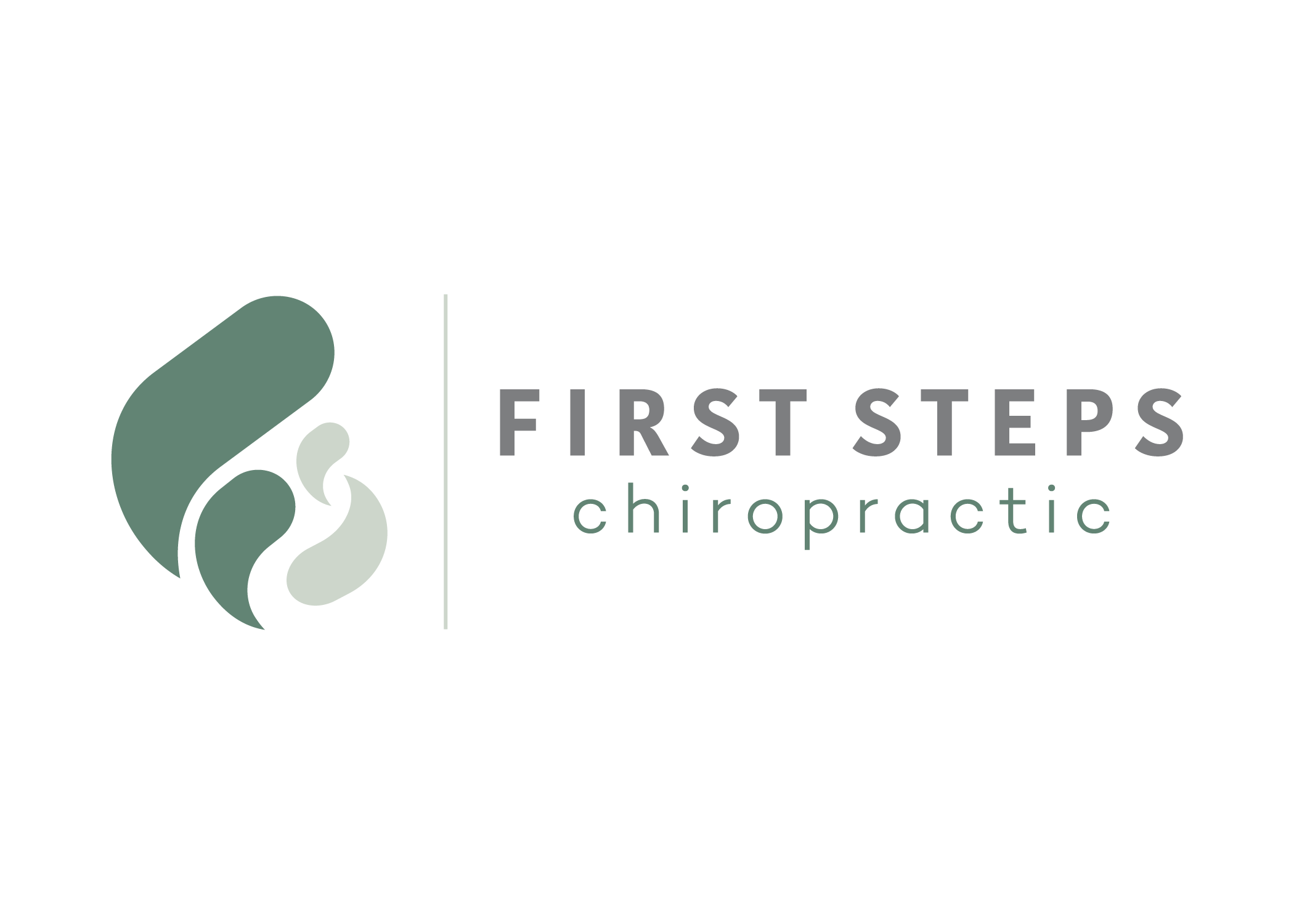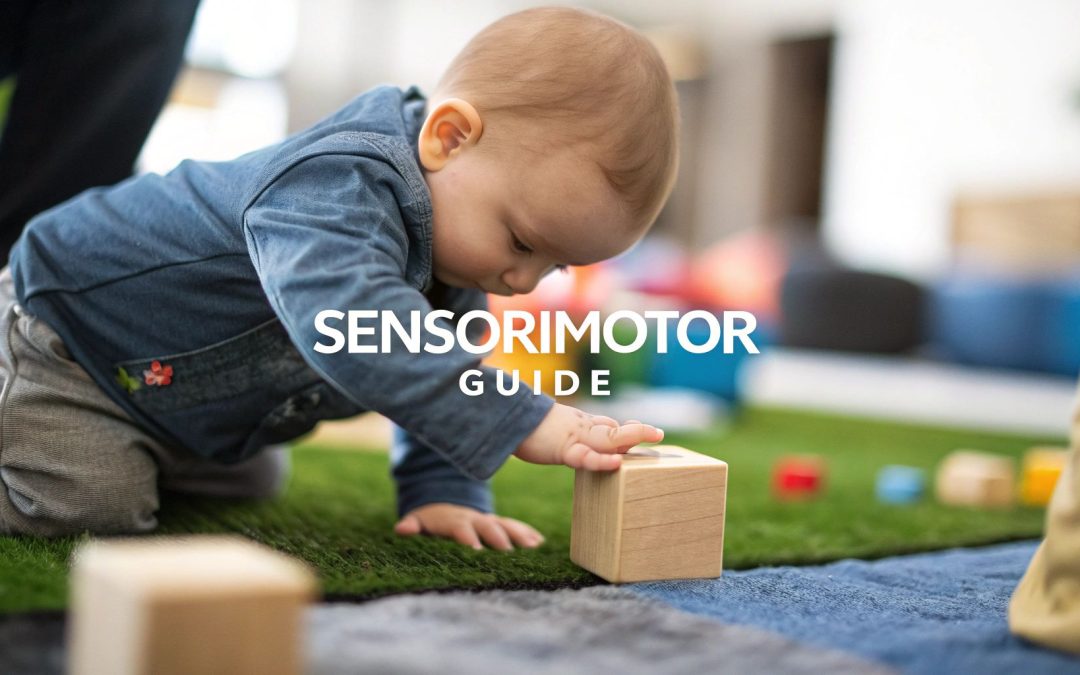From the moment they’re born until they’re taking their first wobbly steps as a toddler, your baby is on a whirlwind journey of discovery. This foundational period, which psychologist Jean Piaget called the stages of sensorimotor development, lasts from birth to about two years old.
During this time, infants don’t understand the world through abstract thought; they build their reality through direct sensory experiences and physical actions. You can almost think of it as your baby installing their very first operating system for how the world works.
Your Baby's First Operating System
A baby’s brain isn’t just a miniature version of an adult’s—it’s a dynamic, ever-changing construction site. In these first two years, they aren’t just passively watching the world go by. They are actively building a mental blueprint of it, piece by piece. Every touch, taste, sound, and movement provides a critical byte of data.
This whole process is broken down into six distinct substages. It all starts with the most basic, instinctual reflexes and wraps up with the very beginnings of symbolic thought and real problem-solving. It’s a fascinating journey from simply reacting to their environment to intentionally acting on it.
When you understand these phases, you start to see the genius behind your baby's seemingly random actions.
The Blueprint for Learning
The entire sensorimotor stage is built on a beautifully simple premise: we learn by doing. A baby doesn’t know what a rattle is because someone told them. They learn by shaking it, hearing the sound it makes, feeling its texture, and probably sticking it in their mouth.
- Senses as Tools: Their hands, mouth, eyes, and ears are their primary tools for exploring everything around them.
- Actions as Experiments: Kicking their legs in the crib, dropping a toy from the high chair (over and over again), or splashing in the bath are all tiny experiments that teach crucial lessons about cause and effect.
- Building Mental Maps: Each interaction helps them construct “schemas,” which are like mental file folders for organizing all their new experiences.
This timeline gives you a great visual of how a newborn’s reflexive world blossoms into a toddler's much more intentional and curious exploration.
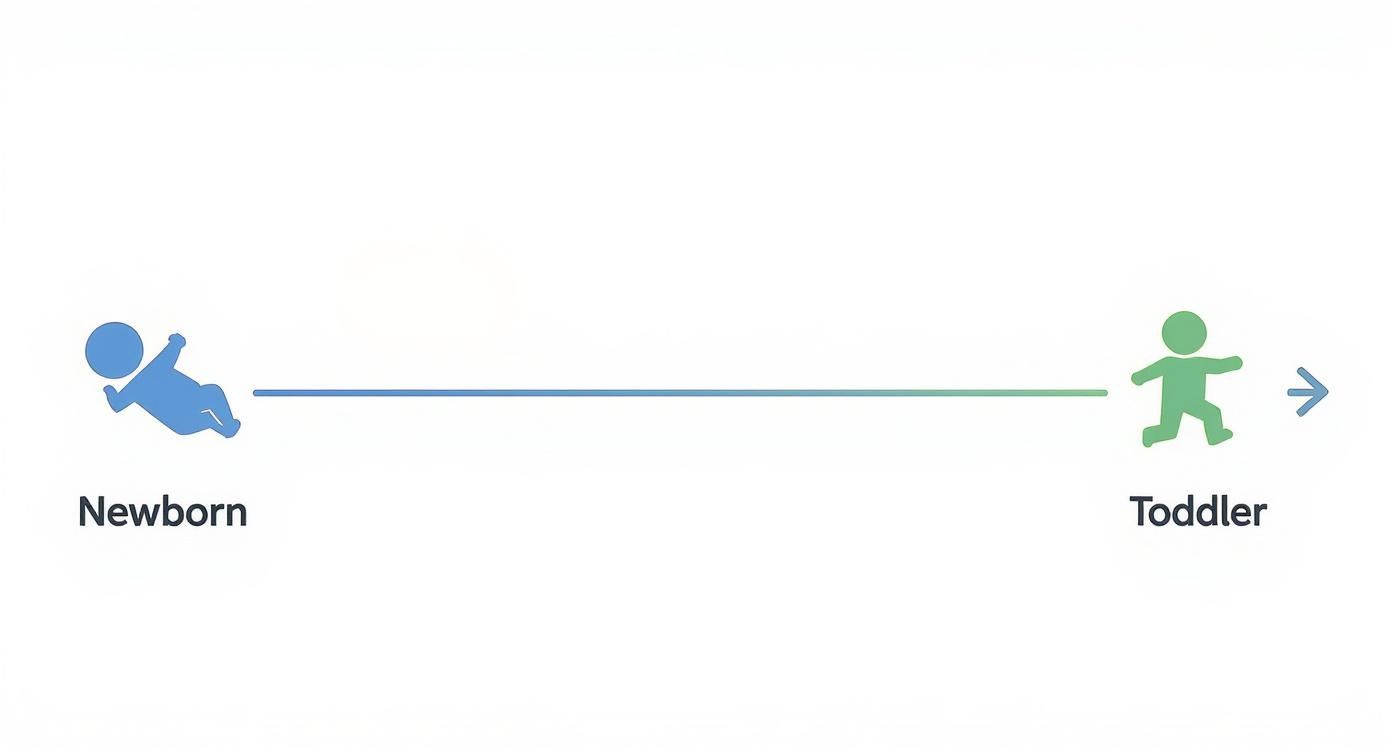
As you can see, the experiences they have in these first two years are truly paving the way for more complex thinking and learning later on.
To help you keep track, here's a quick overview of the six substages that make up this incredible period of growth.
Overview of the Six Sensorimotor Substages
| Substage | Typical Age Range | Key Developmental Milestone |
|---|---|---|
| 1. Reflexive Acts | 0–1 Month | Learning about the world through innate reflexes like sucking and grasping. |
| 2. Primary Circular Reactions | 1–4 Months | Repeating enjoyable actions centered on their own body (e.g., sucking their thumb). |
| 3. Secondary Circular Reactions | 4–8 Months | Repeating actions that involve objects in the environment (e.g., shaking a rattle). |
| 4. Coordination of Reactions | 8–12 Months | Combining schemas to achieve a goal; beginning of intentional action. |
| 5. Tertiary Circular Reactions | 12–18 Months | Experimenting with new behaviors to see the results ("little scientist" phase). |
| 6. Early Representational Thought | 18–24 Months | Beginning of symbolic thought and understanding object permanence fully. |
Each of these substages is a vital stepping stone for both cognitive and motor skill development. The very first one, Reflexive Acts (0-1 month), is guided by those built-in reflexes like sucking and grasping. These aren't just random actions; they form the initial schemas that all future, more advanced learning is built upon. You can learn more about these foundational schemas and their impact on early learning.
From Reflexes to First Discoveries
The first six months of your baby's life are an absolute whirlwind of foundational growth. This period covers the first three critical stages of sensorimotor development, marking a fascinating transformation from an instinct-driven newborn to a tiny explorer who’s starting to interact with the world in more purposeful ways.
Every coo, kick, and grasp is so much more than just a cute action—it's a building block in their understanding of reality. Let's break down this incredible journey.
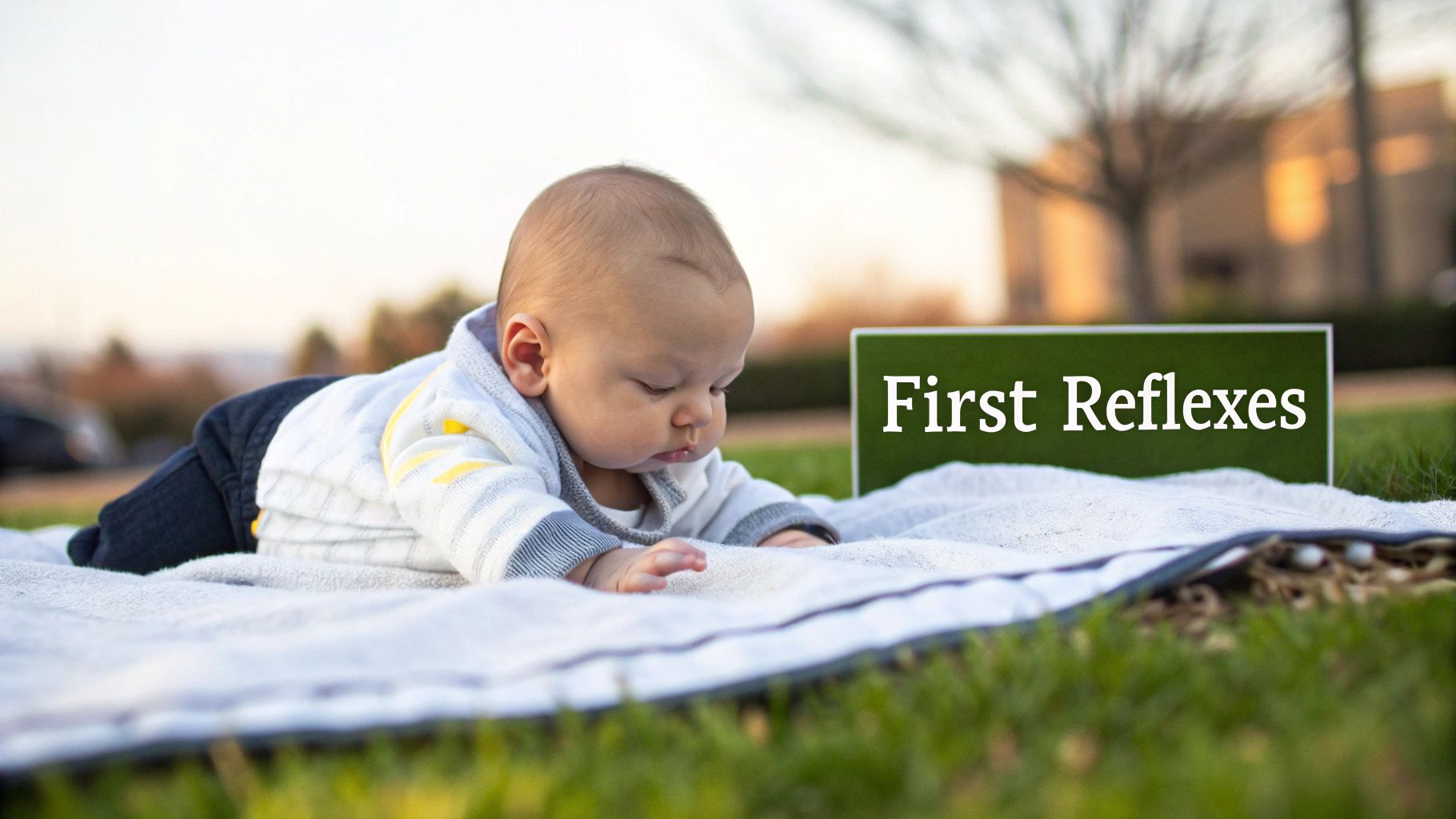
Stage 1: Reflexive Schemes (0 to 1 Month)
In that very first month, your baby operates almost entirely on autopilot. This initial stage is defined by reflexive schemes—the innate, automatic responses they are born with. Think of these as their survival starter pack, hardwired directly into their developing nervous system.
Actions like the rooting reflex (turning their head to find a nipple) or the powerful grasping reflex (squeezing your finger tight) aren't conscious choices. They are pure instinct, behaviors designed to help them survive and begin their very first interactions with the environment.
While these actions are automatic, they are also the very first mental maps, or "schemas," your baby forms. The act of sucking, for example, is initially just a reflex. But through experience, it becomes a skill they can start to control, applying it to a pacifier, a bottle, or even their own fist.
These early reflexes are the foundation upon which all future learning is built. They are the initial sparks that ignite the engine of cognitive development, setting the stage for more complex, intentional actions in the months to come.
Stage 2: Primary Circular Reactions (1 to 4 Months)
As they move into the second stage, something amazing starts to happen. Your baby stumbles upon an action—often involving their own body—that feels interesting or pleasurable, and then they try to do it again… and again. This is the hallmark of primary circular reactions.
The focus here is entirely on their own body. They aren't trying to make something happen in the outside world just yet. Instead, they’re becoming fascinated by the cause-and-effect relationship of their own movements.
Here are a few classic examples you might start to notice:
- Discovering Their Hands: Your baby might accidentally bring their hand to their mouth, enjoy the sensation, and then spend ages trying to replicate that exact movement.
- Wiggling Toes: They might kick their legs, catch a glimpse of their wiggling toes, become captivated, and repeat the motion just to see it again.
- Making Sounds: They may make a cooing sound by chance, like the feeling, and then try to reproduce that same gurgle or coo.
These repetitive actions are your baby’s first real experiments. They are learning to coordinate their senses with their motor skills, turning an accidental discovery into an intentional, repeated act. It’s a huge leap from the purely reflexive behavior of the first month.
Stage 3: Secondary Circular Reactions (4 to 8 Months)
Now, the world starts to get a whole lot bigger. In this third stage, your baby's focus shifts from their own body to the objects and people around them. This phase is called secondary circular reactions, and it marks the beginning of their interaction with the external environment.
The key difference is that the repeated action is now designed to produce a result outside of their own body. They’re realizing their actions can have a direct and interesting impact on the world.
This is when play starts to become much more interactive and purposeful. You'll see this stage in action when your baby:
- Shakes a Rattle: They shake a rattle once, hear the sound, and then intentionally shake it again to recreate that exciting noise.
- Kicks a Mobile: They kick their legs in the crib, notice it makes the mobile above them spin, and then start kicking with the clear intention of making it move.
- Splashes in the Bath: They accidentally splash the water, delight in the result, and then continue splashing to see it happen again and again.
During this stage, your baby is no longer just a passive observer; they are an active participant, learning that they have the power to influence their surroundings. This foundational understanding of cause and effect is a monumental step in their cognitive journey, setting the scene for the more goal-oriented behaviors that will emerge next.
Becoming a Little Problem Solver
Right around the eight-month mark, you're going to see a fascinating shift in how your baby interacts with the world. Those random, happy-accident discoveries of the last few months start to look a lot more intentional. This is the fourth stage of sensorimotor development, what experts call the Coordination of Secondary Circular Reactions, and it really takes off between 8 and 12 months.
Think of this as the dawn of true problem-solving. Your little one is no longer just repeating an action because it feels good or makes a neat sound. Now, they're starting to string together different actions—or schemas—to make something specific happen. You’re seeing the very first glimmers of real, undeniable intention.
The Rise of Goal-Oriented Action
Up until now, your baby's interactions have been mostly about cause and effect. Shake a rattle, it makes a sound. Fun! Let's do it again. But now, they start connecting those behaviors with a clear goal in mind. They see what they want, and they begin to strategize how to get it.
For instance, they might see their favorite rattle just out of reach, with another toy blocking the way. A younger baby might just get frustrated, but a baby in this stage will deliberately push the obstacle aside first, and then grab the rattle. This multi-step process shows their brain is building the ability to plan and interact with their environment in a much more sophisticated way. You can read more about how babies use their budding knowledge to achieve goals in WebMD's guide to the sensorimotor stage.
A World Beyond Sight
The real superstar of this stage, though, is object permanence. This is the game-changing realization that things (and people!) continue to exist even when they’re completely out of sight. Before this huge cognitive leap, your baby’s world was very "out of sight, out of mind." If they couldn't see it, it simply wasn't there.
Now, a profound mental shift is happening. Your baby is starting to understand that when you hide their favorite giraffe under a blanket, the giraffe is still there, just waiting to be discovered. This is exactly why games like peek-a-boo suddenly become the most hilarious, thrilling activity on the planet.
The absolute delight your baby shows during peek-a-boo isn’t just about your funny faces. It’s the sheer joy of their brain confirming what it’s just beginning to grasp: you disappeared, but you came back—just like you were supposed to!
This incredible new understanding fuels a powerful desire to search, explore, and investigate. They'll now actively look for hidden objects, pulling away blankets or peering around corners to find what they're looking for. This simple game is actually a serious cognitive workout, strengthening their memory and cementing this crucial concept of permanence. Of course, healthy motor function is key for this kind of exploration. You can learn more about supporting gross motor delays and developmental milestones in our guide.
Encouraging Your Little Planner
This is such a fun time to engage with your baby through simple, goal-oriented play. These activities aren't just for entertainment; they are actively helping to build and strengthen the crucial neural connections firing away in their brain.
Here are a few practical ways to support these emerging skills:
- Simple Hiding Games: Start by partially hiding a favorite toy under a small cloth and encouraging them to find it. As they get the hang of it, you can hide it completely.
- Obstacle Courses: Place a soft pillow or cushion between your baby and a toy they love. This motivates them to navigate around the obstacle, putting that multi-step problem-solving into practice.
- Container Play: Give them boxes or containers with toys inside. They'll have to figure out how to open the container (one action) to get to the toy (the goal).
By creating these simple problem-solving opportunities, you're helping them build the confidence and cognitive framework they’ll need for the even more complex stages of development that are just around the corner.
Exploring the World Like a Scientist
Between 12 and 18 months, your toddler’s playroom officially turns into a science lab. We've now entered the fifth stage of sensorimotor development, known as Tertiary Circular Reactions. If the earlier stages were all about repeating actions to get a familiar result, this stage is driven by one powerful question: "What if?"
Welcome to the era of the little scientist. Your child isn't just dropping a spoon from their high chair anymore; they're an active experimenter. They might drop it gently one moment, then chuck it with force the next, or even hold it at a different angle just to see what happens. Every single action is a brand-new test, a new hypothesis they're exploring in real time.
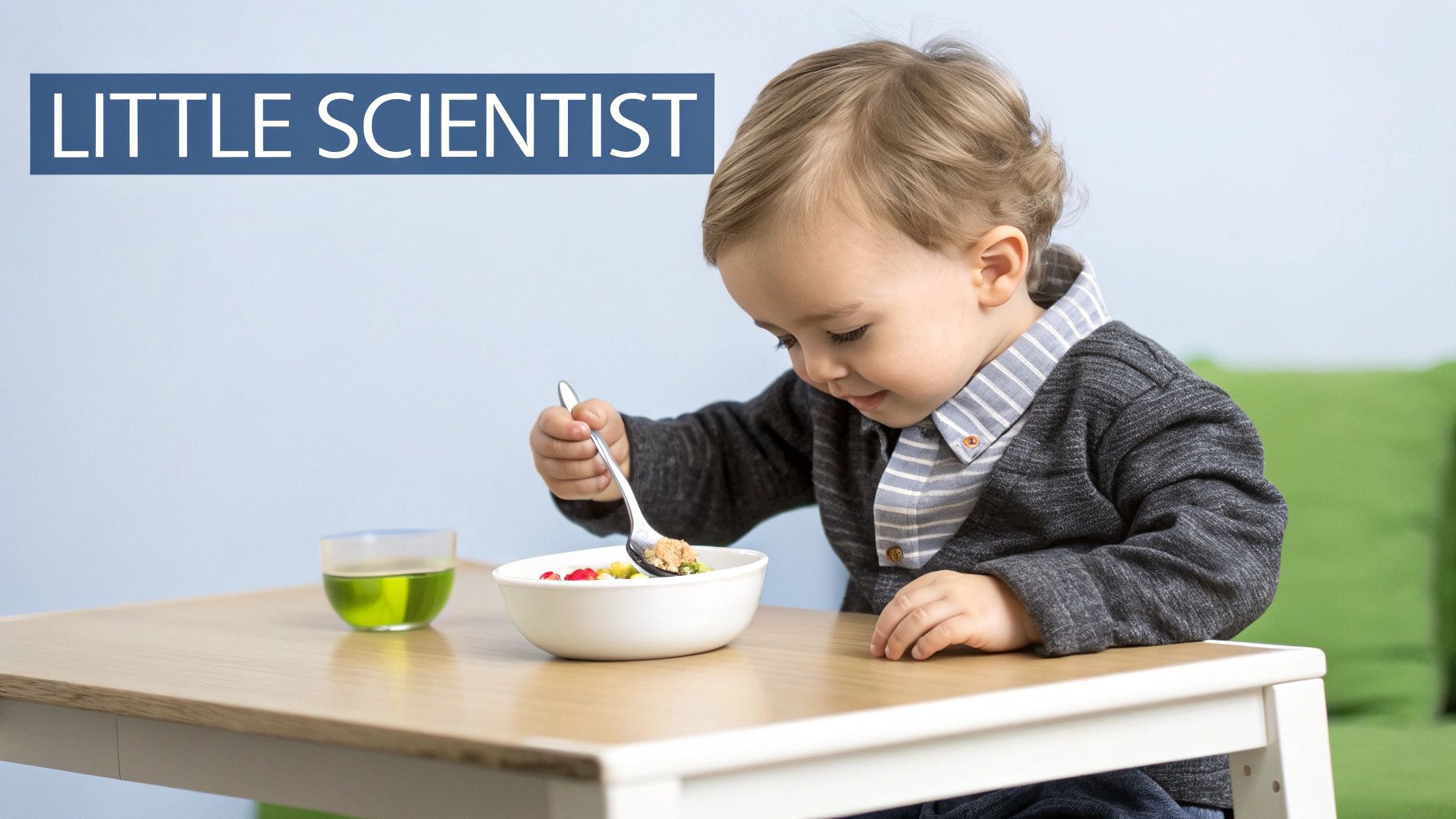
This entire phase is fueled by pure, unfiltered curiosity. The goal is no longer just to recreate something fun but to discover entirely new outcomes. This trial-and-error approach is exactly how they build a much deeper understanding of how the world works and their own ability to make things happen. Trust me, the mess they make is simply the byproduct of a brilliant mind hard at work.
The Age of Active Experimentation
During this pivotal period, your toddler graduates from simple cause-and-effect. Now, they're actively changing their actions to see what different outcomes they can produce. They're learning that tiny tweaks in what they do can lead to big differences in the results—a huge leap in cognitive function and a cornerstone for creative problem-solving down the road.
This hands-on learning helps them grasp complex ideas in a way they can actually feel and see. It’s one thing to know that dropping a block makes a noise. It’s a completely different level of understanding to learn that dropping it on a soft rug makes a quiet thud, while dropping it on the hardwood floor creates a satisfyingly loud clack.
These constant experiments are also fine-tuning their motor skills and spatial awareness. The very act of manipulating objects in different ways strengthens their hand-eye coordination and their internal sense of where their body is in space. For a deeper look at this, you can explore how proprioception is a key piece in your child's development puzzle.
Signs Your Little Scientist Is at Work
Recognizing this stage is pretty easy once you know what you're looking for. These behaviors are clear signals that your child is running experiments on their environment.
- Varying Actions: You might see them stack blocks until they fall over, then try stacking them in a new way to see if they can build a taller tower.
- Exploring Containers: Filling things up and dumping them out becomes an all-time favorite activity. They'll put toys in a bucket, dump them out, then try putting totally different objects inside just to see how they fit.
- Testing Physics at Mealtime: Food is no longer just for eating; it's for science. They might squish a banana to feel its texture, drop peas one by one to watch them bounce, or pour water from one cup into another (and another).
This stage is a beautiful (and yes, often messy) display of active learning. Every spilled cup and dismantled toy is a successful experiment, teaching your toddler invaluable lessons about how the physical world operates.
How to Nurture Their Curiosity Safely
Your role during this stage is to be the best lab assistant you can be. That means providing interesting materials and making sure the "lab" is a safe place to work. You don't need fancy, expensive toys; simple, everyday objects are often the most fascinating to a budding scientist.
Here’s how you can create an environment that fuels their scientific mind:
- Offer Safe Materials for Exploration: Provide items like plastic containers, wooden spoons, stacking rings, and large, non-toxic blocks. These open-ended toys allow for endless experimentation.
- Embrace Water and Sand Play: A small water table or a sand bin is the perfect medium for exploring concepts like volume, texture, and gravity in a somewhat contained space.
- Childproof the Environment: Since their curiosity will lead them absolutely everywhere, make sure their exploration zone is safe. Cover electrical outlets, secure heavy furniture, and keep small, hazardous objects well out of reach.
By supporting their need to explore, you're doing more than just encouraging one of the key stages of sensorimotor development. You are fostering a lifelong love of learning and discovery.
The Dawn of Imagination and Thought
As your toddler barrels toward the 18 to 24-month mark, get ready for a truly magical shift. They’re entering the sixth and final stage of sensorimotor development, a phase often called Internalization of Schemes or Early Representational Thought. This is where the constant physical trial-and-error of the "little scientist" stage starts moving inward, transforming into mental problem-solving.
This is the dawn of true imagination. For the very first time, your child can conjure up mental pictures of objects and events that aren't right in front of them. This incredible new ability to think symbolically is a total game-changer, laying the foundation for language, creativity, and abstract thinking for the rest of their lives.
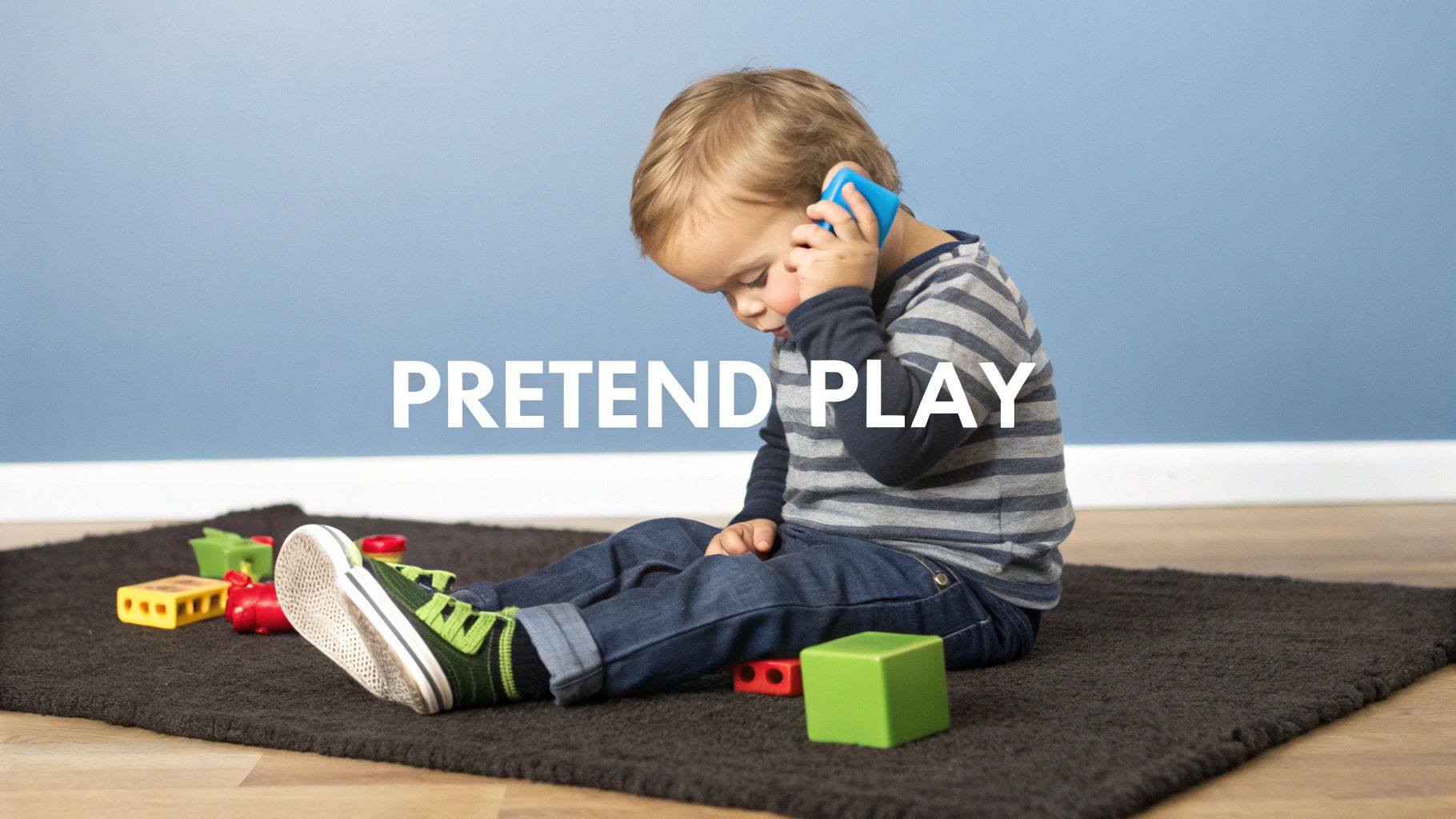
From Physical Actions to Mental Pictures
Until now, your child's problem-solving has been completely hands-on. If they wanted to figure out if a block would fit in a bucket, they had to physically try it. Now, you’ll start seeing them pause, look at the block, look at the bucket, and almost seem to "think it through" before making a move.
That little pause is revolutionary. It signals that they are mentally rehearsing the action and picturing the outcome in their mind's eye without needing to physically perform the experiment. They are moving from a world of pure action to one where thought comes first.
The Magic of Symbolic Thought and Pretend Play
The most delightful and obvious result of this stage is the explosion of pretend play. This is where their new talent for using symbols really shines. An object is no longer just what it is; it can now stand for something else entirely.
This period is all about the emergence of symbolic thought. Toddlers start using mental representations for all sorts of things, like picking up a banana and holding it to their ear like a telephone. This development also brings on milestones like deferred imitation and representational play. You can find more insights on Piaget's theories on SimplyPsychology.org.
You'll see this amazing new skill pop up in all kinds of ways:
- Pretend Play: A plain wooden block might suddenly become a race car, a piece of pizza, or a phone. This ability to give an object a whole new identity is a clear sign of symbolic thinking.
- Deferred Imitation: This is when your toddler mimics something they saw you do hours or even days ago. They might "sweep" the floor with a toy broom or pretend to "talk" on the phone just like you did. It shows they stored a mental image of the action and can pull it out later.
- Early Language Use: Words are symbols, too. When they start using words to ask for objects that aren't in the room, they are showing off this new representational skill.
When your toddler hands you a leaf and proudly declares it's a "cookie," celebrate! This isn't just a cute moment; it's a massive cognitive leap. They are showing you they understand that one thing can be used to represent another—the very foundation of all abstract thought.
Fostering Your Toddler's Growing Imagination
Supporting this stage is all about encouraging their budding creativity. Your goal is to give them the tools and the freedom to bring their amazing mental pictures into the real world.
Here are a few simple ways you can nurture their imagination:
- Provide Open-Ended Toys: Things like blocks, play-doh, dress-up clothes, and even cardboard boxes are perfect. Unlike a toy with a single purpose, these items can become anything your toddler can dream up.
- Engage in Their Pretend Play: If they offer you a "cup of tea" from an empty cup, take a sip and say "thank you!" When you participate, you validate their imaginative world and encourage them to expand on it.
- Read and Tell Stories: Reading books and telling simple stories helps them connect words and pictures to abstract ideas and events, which makes their representational skills even stronger.
This final chapter of the sensorimotor journey is truly remarkable. Your little one is transforming from a baby who learns only through senses and actions to a little person with a rich inner world full of thoughts, memories, and a boundless imagination.
How to Support Each Developmental Stage
Knowing the theory behind your baby’s sensorimotor stages is one thing, but actually putting that knowledge into practice day-to-day is another. The good news? You don't need to be a formal teacher with a curriculum. Your most important role is simply being a supportive guide.
It’s the simple, everyday interactions that pack the most punch when it comes to building your baby's brain. The real magic happens when you create a responsive and enriching environment that meets them exactly where they are. This means turning daily routines into powerful moments for connection and learning, which has a massive impact on their cognitive and motor growth.
Activities for Early Exploration (0 to 8 Months)
In these very first months, your baby’s world revolves around sensory input and your responses. This period covers the first three substages—Reflexive Acts, Primary Circular Reactions, and Secondary Circular Reactions. Your little one is just figuring out their own body and starting to realize they can make things happen in the world around them.
Simple, gentle activities are the most effective right now, as their sensory system is still maturing.
- Tummy Time: This is non-negotiable! Tummy time builds the neck, shoulder, and core strength that forms the foundation for every future motor skill, from sitting up to crawling.
- Varied Textures: Let your baby’s hands and feet explore everything. Think soft blankets, crinkly toys, smooth wooden blocks, and even the cool feeling of grass. This sensory input is busy building crucial neural connections in their brain.
- Responsive Talk: When your baby coos, babbles, or makes any sound, talk back! This back-and-forth "conversation" teaches them the rhythm of language and the fundamentals of social connection long before they can say a single word.
Some babies can be extra sensitive to certain textures or movements. It's helpful to understand what these sensory challenges look like, and you can learn more in our guide on recognizing sensory processing disorder in infants.
Fostering Intentional Action (8 to 18 Months)
Now things get really fun. This phase covers the Coordination of Reactions and Tertiary Circular Reactions stages. Your baby has transformed into a little scientist, intentionally experimenting with cause and effect to solve problems. Your job now is to create a safe lab for them to test their theories.
Your child's mess is often a sign of their mind at work. Every dropped spoon and emptied container is a successful experiment, teaching them valuable lessons about how the physical world operates.
Lean into this budding curiosity with simple challenges that reward their efforts.
- Container Play: Give them empty boxes, bowls, and large, safe objects to put in and take out. This is a masterclass in object permanence, spatial awareness, and fine motor skills, all disguised as simple fun.
- Simple Hiding Games: Peek-a-boo and hiding a favorite toy under a blanket are more than just games. They actively reinforce the concept that things still exist even when they can't be seen.
- Safe Exploration Zones: Baby-proof a "yes" space where they can freely move, pull up on furniture, and investigate their surroundings without you having to say "no" constantly.
By giving them these opportunities, you’re not just keeping them busy; you’re nurturing their independence and building their confidence as capable little learners. This is a huge step in their journey through the stages of sensorimotor development.
Common Questions About Sensorimotor Development
It's completely normal to have a ton of questions as you watch your baby navigate the incredible journey of sensorimotor development. You might wonder about timelines, which toys are actually helpful, and how all this early exploration connects to bigger skills down the road. Let's tackle some of the most common questions we hear from parents.
What If My Baby Misses a Milestone?
First, take a deep breath. It’s so important to remember that developmental timelines are just a guide, not a strict deadline. Every single child has their own unique internal clock for growth and development. The age ranges for each sensorimotor stage are just a typical window—there’s a huge spectrum of what’s considered normal.
Often, a slight delay in one area is simply because your baby is working extra hard on another skill. A baby who is laser-focused on mastering fine motor skills like grasping and pinching might take a little longer to start crawling. The real key is to look for steady, forward progress over time, not to get hung up on a specific date on the calendar.
Choosing the Best Toys for Development
In a world overflowing with flashy, noisy, electronic toys, the best tools for sensorimotor learning are often the simplest ones. The goal isn't passive entertainment; it's to find items that spark active exploration and get their little brains problem-solving.
Think about toys that really engage their senses and invite them to experiment.
- Open-Ended Objects: Items like stacking rings, nesting cups, and classic wooden blocks are perfect. There’s no "right" way to play with them, which fuels creativity and powerful trial-and-error learning.
- Sensory-Rich Toys: Look for things with different textures (crinkly, smooth, bumpy), sounds (rattles, bells), and materials that are safe for mouthing, because you know that's where everything ends up!
- Problem-Solving Play: Simple shape sorters or even just a container with large objects to put in and take out are fantastic for building foundational cognitive skills.
The most valuable "toy" is one that requires your child to do something. If the toy does all the work, your child’s brain isn’t being challenged to build those crucial new connections.
How Does This Stage Prepare My Child for Talking?
It might not seem obvious, but the physical, hands-on learning of the sensorimotor stage is a direct runway to language. Before a child can say the word "ball," they first have to truly experience it—holding it, rolling it, dropping it, and understanding that it’s a separate object from themselves. This builds a rich mental library of concepts that words will later get attached to.
Think about it: when your baby pushes a block out of the way to get to a rattle, they're learning about cause, effect, and intention. These are the very same cognitive building blocks needed to understand that using a specific word can cause a specific result, like saying "cup" to get a drink. Every single physical interaction is laying the essential groundwork for communication.
At First Steps Chiropractic, we know that a healthy, well-adjusted nervous system is the foundation for every single developmental milestone. If you have concerns about your child's progress, we're here to offer a supportive, neurologically-focused approach to help them thrive. Learn more about our pediatric chiropractic care and how we can help your family.
